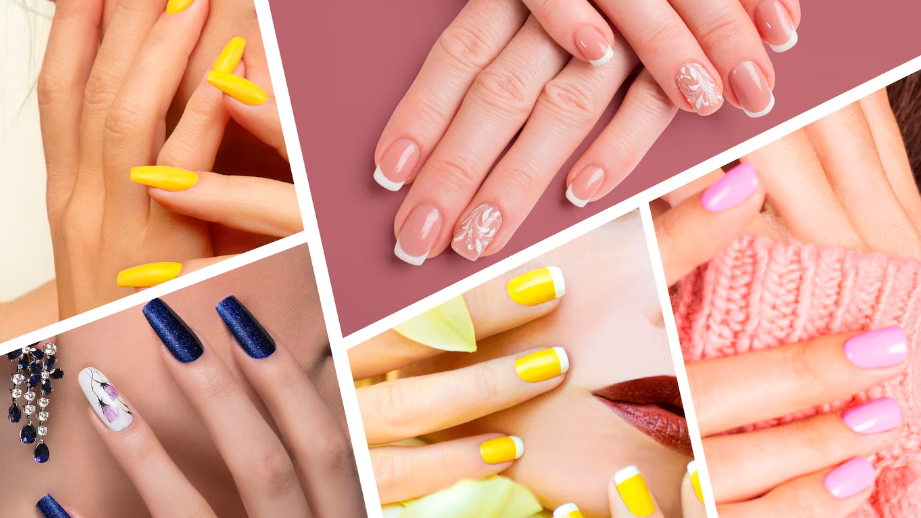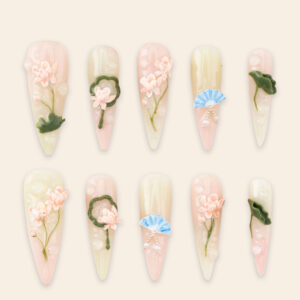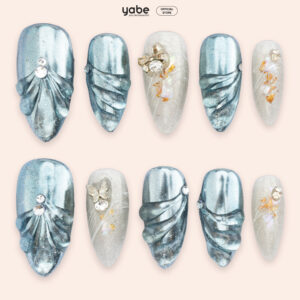Choosing between press-on nails vs acrylics can feel overwhelming, especially when both offer stunning results. But the best choice depends on your lifestyle, budget, and personal preferences. In this guide, we’ll break down the key differences between press-on nails and acrylics, helping you make an informed decision that fits your needs perfectly.

Understanding Press-On Nails vs Acrylic Nails
Let’s explore what sets these two types of artificial nails apart.
What Are Press-On Nails?
Press-on nails are pre-designed artificial nails that you attach to your natural nails using adhesive glue or tabs. Available in countless styles and sizes, they offer a quick and easy solution for at-home manicures without needing professional tools or salon visits.
What Are Acrylic Nails?
Acrylic nails are created by mixing a liquid monomer and a powder polymer to form a hard protective layer over your natural nails. Applied and shaped by professionals, they offer a strong and long-lasting option often used for intricate designs and extensions.

Press-On Nails: Pros and Cons
Consider why press-on nails are a growing favorite and where they may fall short.
Advantages of Press-On Nails
- DIY Friendly: Easily applied at home in under 30 minutes.
- Affordable: Much cheaper than salon acrylics.
- Damage-Free: Less likely to harm natural nails when properly removed.
- Versatile: Available in a wide range of styles and shapes.
Disadvantages of Press-On Nails
- Shorter Lifespan: Typically last 5–10 days.
- Less Durable: More prone to lifting or falling off with intense hand use.
- Limited Length Options: Not as customizable in shape and extension as acrylics.
Acrylic Nails: Pros and Cons
Now let’s explore what makes acrylics a salon staple and their potential drawbacks.
Advantages of Acrylic Nails
- Durable and Long-Lasting: Can last 3–4 weeks with fills.
- Customizable: Perfect for shaping, extending, and detailed nail art.
- Professional Finish: Offers a flawless, sculpted appearance.
Disadvantages of Acrylic Nails
- Time-Consuming: Requires a salon visit and professional application.
- Expensive: Higher upfront and maintenance costs.
- Nail Damage Risk: Improper application or removal can severely damage natural nails.

Cost Comparison: Press-On vs Acrylic Nails
Initial Costs
- Press-Ons: Range from $5 to $30 per set, sometimes reusable.
- Acrylics: Initial full set typically costs $40–$100, depending on design complexity.
Long-Term Maintenance Costs
- Press-Ons: Minimal—mainly for new sets or glue.
- Acrylics: Require fills every 2-3 weeks, adding $25–$60 per visit.
Durability and Longevity Differences
Which Lasts Longer?
Acrylic nails last longer, maintaining strength and design for weeks. Press-ons are better for short-term wear or specific events.
Daily Wear and Tear Resistance
Acrylics resist chipping and bending, while press-ons may loosen with heavy hand use, such as typing, dishwashing, or sports.

Application Process: DIY vs Salon Visit
Ease of Application
Press-ons are user-friendly and can be applied at home. Acrylics demand professional application and shaping tools.
Time Investment for Each Method
- Press-Ons: 15–20 minutes.
- Acrylics: 1.5–2 hours, including shaping and curing.

Health and Safety Considerations
Your natural nail health should always be a priority when choosing between press-on nails and acrylics.
Impact on Natural Nails
- Press-On Nails: Cause minimal damage if removed properly and infrequently. Since they don’t involve heavy filing or chemicals, your natural nails are less likely to become thin or brittle.
- Acrylic Nails: Frequent use and improper removal can weaken and thin natural nails over time, especially if the nail bed is over-filed during application.
Chemical Exposure and Allergy Risks
- Press-Ons: Typically come pre-made and don’t require harsh chemicals. However, low-quality adhesives may still cause skin irritation in sensitive individuals.
- Acrylics: The liquid monomer used in acrylic application emits strong fumes and contains chemicals like MMA (in some non-regulated salons), which may trigger allergic reactions or respiratory issues.
Design Flexibility and Aesthetic Options
Both options offer variety in style but differ in how much customization you can achieve.
Customization Options
- Press-On Nails come in pre-designed shapes, colors, and lengths, but can be filed and painted to some extent. Compared to acrylics, they are limited in customizability.
- Acrylics: Offer full control over length, shape, and design. Ideal for custom nail art, ombré effects, encapsulated glitter, and 3D elements.
Trendy Styles and Seasonal Looks
Both press-ons and acrylics follow fashion trends. While acrylics may be better suited for complex nail art, press-ons quickly adapt to seasonal themes with less commitment.

When to Choose Press-On Nails Over Acrylics
Knowing when to pick press-ons can help save time and money without compromising style.
Best Use Cases for Press-On Nails
- Special Occasions: Weddings, parties, or vacations where short-term glam is needed.
- Trial Looks: Trying out a new design or shape before committing to acrylics.
- You’re on a Budget or in a Rush: Quick and wallet-friendly manicures anytime, anywhere.
When to Avoid Acrylics
- Acrylics can worsen existing nail problems if you have weak or damaged nails.
- If You’re Sensitive to Fumes or Chemicals: Acrylic application may trigger allergies or respiratory issues in some people.
When to Choose Acrylic Nails Over Press-Ons
Acrylics are best for those who need a long-lasting, professional look with robust durability.
Occasions That Require Long-Lasting Nails
- Vacations: No worries about nails falling off mid-trip.
- Special Events Spanning Multiple Days: Great for weddings or long celebrations.
Situations Where Acrylics Excel
- For Nail Biters: Acrylics act as a barrier and prevent biting.
- For Those Who Want Extended Length: Ideal for dramatic nail styles and longer shapes.

Real User Experiences and Testimonials
Hearing from users offers a real-world look into the advantages and disadvantages of both options.
What Users Love About Press-Ons
- “So easy and quick to apply before events!”
- “They saved me when I couldn’t get a salon appointment.”
- “Great for experimenting with new styles.”
Why Some Still Prefer Acrylics
- “They last longer and look perfect for weeks.”
- “I love the custom designs I get from my nail tech.”
- “Ideal for keeping a polished look through my busy schedule.”
Frequently Asked Questions (FAQs)
-
Which is safer for your natural nails—press-ons or acrylics?
Press-ons are safer overall, especially if removed properly and not worn continuously.
-
Can you wear press-ons over acrylics?
No, it’s not recommended. Press-ons are designed to be worn directly on natural nails.
-
Do acrylics last longer than press-ons?
Yes, acrylics typically last 2-4 weeks, while press-ons usually last up to 10 days.
-
Which looks more natural—press-on nails or acrylics?
Both can look natural depending on the application, but custom acrylics may offer a more seamless, salon-polished look.
-
Can I swim or shower with press-ons?
Yes, but limit water exposure immediately after application. Acrylics generally handle water better.
-
Do press-ons feel as strong as acrylics?
Press-ons are more lightweight and flexible, while acrylics feel harder and more robust.
Conclusion: Choosing the Right Nail Type for Your Lifestyle
Press-on nails and acrylics offer stunning results, but the right choice depends on your lifestyle, budget, and needs. If you’re looking for quick, affordable, and damage-free glam, press-ons are a fantastic option. If durability, custom designs, and a long-lasting manicure are your priorities, acrylics may be worth the investment. Either way, with the right knowledge, you can enjoy beautiful, healthy nails that fit seamlessly into your life.




